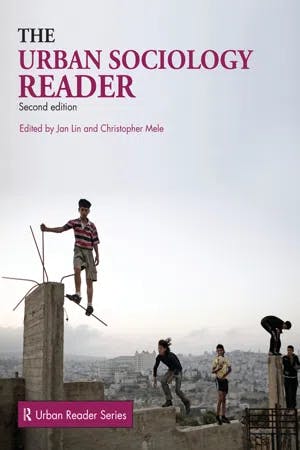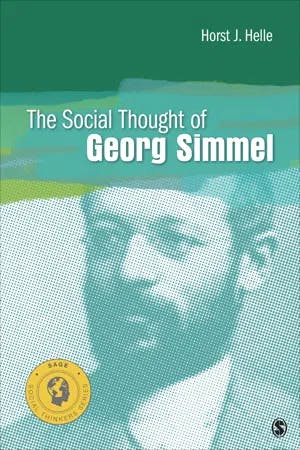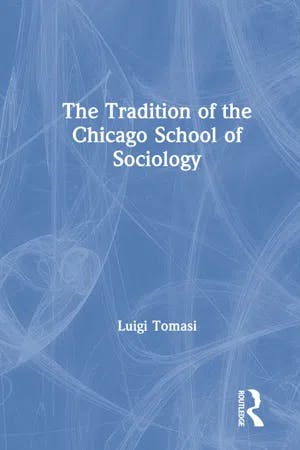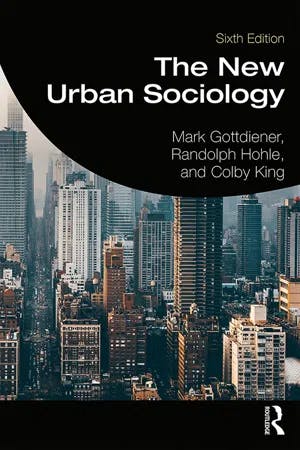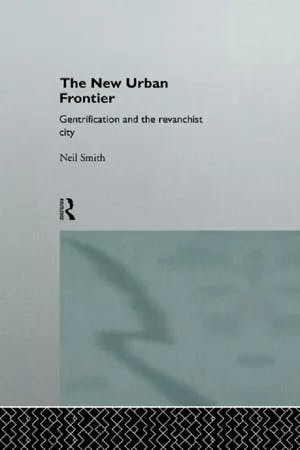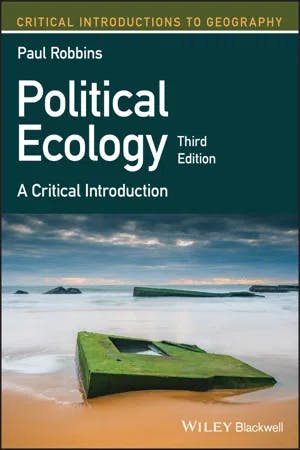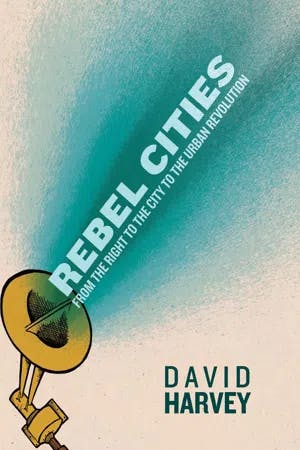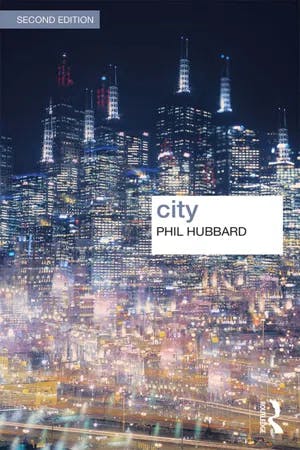What is Urban Sociology?
MA, Sociology (Freie Universität Berlin)
Date Published: 23.11.2023,
Last Updated: 23.11.2023
Share this article
Defining urban sociology
Urban sociology is the study of the structures and processes that shape our urban environment, and how these mechanisms, in turn, affect human behavior and social cohesion. This was a topic of import to early classical sociologists and has remained prevalent, particularly in American sociology over the last century. The study of urban environments has inspired a number of key sociological theories and approaches such as functionalism, conflict theory, and the Chicago School. Cities provide such an important context for sociological study because, as Jan Lin and Christopher Mele explain,
Cities are focal arenas for the contemplation of the human condition and man’s struggle for self-expression. Cities are landscapes of cultural diversity and subcultural differentiation. [...]The bohemias, bright light districts, and red light districts of the city are crucibles for the exploration of artistic, cultural, and sexual expression. The city contains our workplaces, our residences, and our commercial marketplaces. The metropolis is a terrain of social inequality. [...] Cities are landscapes of gender inequality and social differences in sexuality. Cities are key sites in the transformation of the global economy. There is a new cultural economy of cities that gives us an analytic window on the character of our postindustrial society. (2012)
Edited by Jan Lin & Christopher Mele
Cities are focal arenas for the contemplation of the human condition and man’s struggle for self-expression. Cities are landscapes of cultural diversity and subcultural differentiation. [...]The bohemias, bright light districts, and red light districts of the city are crucibles for the exploration of artistic, cultural, and sexual expression. The city contains our workplaces, our residences, and our commercial marketplaces. The metropolis is a terrain of social inequality. [...] Cities are landscapes of gender inequality and social differences in sexuality. Cities are key sites in the transformation of the global economy. There is a new cultural economy of cities that gives us an analytic window on the character of our postindustrial society. (2012)
Furthermore, as societies around the world continue to trend towards urbanization, the field of urban sociology is increasingly relevant in understanding the impacts of city living, both on individuals and in terms of larger-scale demographic changes.
Today, urban sociologists are particularly concerned with a number of subtopics within the field including crime and deviance, gentrification and homelessness, and the social impacts of urban geography. They are also interested in the positive effects of the city in shaping culture and social movements. Moreover, urban sociologists increasingly look toward the future to consider how issues like climate change, rising housing crises, and technology will influence life in urban areas. This study guide covers these topics to give you a comprehensive overview of the discipline of urban sociology.
History and theories of urban sociology
The discipline of sociology largely emerged in response to industrialization. This rapid transition in society from agricultural production and cottage industries to factory work also precipitated large-scale migration to cities and an overall process of urbanization. Therefore, sociologists have long been interested in the city, dating back to the early days of the discipline. They were curious about how this new kind of social space influenced human behavior both on an individual level to produce feelings of alienation, anomie (the breakdown of ethics and social values), and deviance. Sociologists also explored how urban environments shaped behavior on a collective level to promote mass obedience whilst also, at times, social movements that disrupt the status quo.
To read more about the development of the modern city, check out our guides on modernity, capitalism, and psychogeography.
The city in classical sociological theory
Two classical sociologists who were especially fixated on the study of urban spaces were Émile Durkheim and Georg Simmel. In the case of Durkheim, his analysis of the city gave rise to the macrosociological theory of functionalism, which views a given social context as a complex system or social organism containing a number of interconnected parts. His perspective was groundbreaking because, rather than being reduced to individual psychological motivations, Durkheim argued that people were influenced by the structures of their social environment. As Kenneth Thompson writes,
[Durkheim] was too aware of the sui generis [unique] character of the social. One reason for using the concept of function was that it could be used polemically to combat the contemporary tendency to psychological reductionism and the explanation of social institutions in terms of individuals’ intentions, as in the Utilitarian assumption that institutions were the product of the individual’s search for increased happiness. (2003)
Kenneth Thompson
[Durkheim] was too aware of the sui generis [unique] character of the social. One reason for using the concept of function was that it could be used polemically to combat the contemporary tendency to psychological reductionism and the explanation of social institutions in terms of individuals’ intentions, as in the Utilitarian assumption that institutions were the product of the individual’s search for increased happiness. (2003)
Durkheim was particularly fascinated by the social cohesion, or lack thereof, in cities, where people lived closely alongside each other but often without knowing each other. He theorized that this kind of group anonymity in the modern city gave rise to profound feelings of alienation and anomie. These, Durkheim argued, led to increased crime, deviance, and even a higher prevalence of suicide (for more on these topics see Durkheim’s Suicide: A Study in Sociology [2005] and The Division of Labour in Society [2013]).
German sociologist Simmel was another foundational contributor to the school of urban sociology. In his seminal work Metropolis and Mental Life (1903), Simmel also looked at the psycho-social dimensions of urban spaces. He argued that the fast-paced, regimented nature of the city, combined with the densely populated, diverse, and imposing man-made structures produced new mental states and social relations that were unique to urban life (Simmel, “Metropolis and Mental Life,” in The People, Place, and Space Reader, [2014]). As Horst J. Helle describes it in The Social Thought of Georg Simmel, these conditions led to tensions defined by
[…] the struggle of the individual against being leveled down and made irrelevant by the innovations big cities bring to modern life. This struggle can lead to ruthless selfishness as well as to socialist ideas (and, indeed, to a combination of both). The basic problem, then, is the confrontation between the desire of the individual to protect his or her autonomy and the various pressures to adjust to external forces in modern big cities. (2014)
Horst J. Helle
[…] the struggle of the individual against being leveled down and made irrelevant by the innovations big cities bring to modern life. This struggle can lead to ruthless selfishness as well as to socialist ideas (and, indeed, to a combination of both). The basic problem, then, is the confrontation between the desire of the individual to protect his or her autonomy and the various pressures to adjust to external forces in modern big cities. (2014)
Simmel argued that these environments resulted in higher levels of reserve and detachment from others, in addition to producing more transient and shallow social relationships. His observations also helped lay the groundwork for sociological concepts such as symbolic interactionism, a dimension of micro-sociology concerned with how people interpret meaning through symbols, language, and gestures.
The Chicago School
In the 20th century, the Chicago School of Sociology emerged as a quintessential school of thought within the field of urban sociology. As their name suggests, they were particularly focused on the rapid urbanization of Chicago, a city with a large immigrant population. As Luigi Tomasi writes,
It was this ‘new change’ that gave rise to a different generation of sociologists, one oriented towards gathering knowledge on the zones of the great cities. […] The idea of conducting careful exploration of the unknown territory of the great cities of the Mid-West, studying their most particular features and the specific behaviour of their inhabitants, was accompanied by the development of a theory. (2019)
Luigi Tomasi
It was this ‘new change’ that gave rise to a different generation of sociologists, one oriented towards gathering knowledge on the zones of the great cities. […] The idea of conducting careful exploration of the unknown territory of the great cities of the Mid-West, studying their most particular features and the specific behaviour of their inhabitants, was accompanied by the development of a theory. (2019)
Members of the Chicago School wanted to understand whether American urbanization, and the mythos of social mobility there, have remedied or led to social problems. Somewhat building upon the work of their predecessors such as Simmel, their work in studying the city had a significant impact on developing sociological methods of qualitative study, such as participant observation, symbolic interactionism, and ethnography. Some notable sociologists from this school include George Herbert Mead and Erving Goffman.
Today, urban sociologists — such as Claude Fischer and Barry Wellman — continue to draw on these theories and contributions. They also engage with conflict theory, which is associated with Marxism, to understand the persistence of social inequality, relations of power, and the prevalence of social movements in urban contexts. In addition to the aforementioned theoretical approaches and qualitative methods, urban sociologists today use quantitative methods to examine macro-level patterns in cities, including demographic data like census statistics, to better understand the population compositions and changes within a given urban context. Taken together, urban sociologists use this information and frameworks to examine urban problems like crime, deviance, homelessness, gentrification, and other structural and geographic issues.
Urban problems
Much of urban sociology also engages with how neoliberalism (the orientation of society around market outcomes) impacts contemporary cities. In terms of the aforementioned social problems, neoliberalism has helped exacerbate social inequality by privatizing services that were previously accessible to the public, ranging from social welfare to public gathering spaces. It has also been linked to an increasing emphasis on discipline and security, which has often meant higher degrees of policing and surveillance of marginalized groups and the homeless. Finally, the neoliberal turn has coincided with the financialization of the housing market (using real estate as a profitable form of investment), which has accelerated the processes of gentrification in many cities around the globe. Let’s take a closer look at how these different social problems have taken shape in cities today.
Crime, deviance, and social control
Due to conditions that are unique to cities — larger degrees of anonymity, dense and diverse populations, etc. — cities are often associated with higher crime rates because they are sites that encourage more socially deviant behavior than smaller towns and communities. Whether this is actually true is contested, but as Mark Gottdiener, Randolph Hohle, and Colby King argue, the impacts of crime in densely populated areas have a profound effect on city life:
social problems such as drugs and poverty have a greater impact in large central cities and densely populated suburbs than in less dense areas. In confined urban space under the jurisdiction of a single municipal government or a racially segregated neighborhood, it is the sheer numbers, such as the frequency of murders and other forms of violent crime that turn social problems into grave concerns. (2019)
Mark Gottdiener, Randolph Hohle & Colby King
social problems such as drugs and poverty have a greater impact in large central cities and densely populated suburbs than in less dense areas. In confined urban space under the jurisdiction of a single municipal government or a racially segregated neighborhood, it is the sheer numbers, such as the frequency of murders and other forms of violent crime that turn social problems into grave concerns. (2019)
While it is difficult to assign precise causality in this respect, there is relatively robust evidence that crime rates correlate closely with inequality in cities. This is likely because when access to vital resources is restricted among a certain population but concentrated among another, the former is more likely to turn to criminal behavior in order to survive. In addition to theft, social inequality often intermingles with other criminalized behaviors such as drug use, sex work, and the sale of illicit materials like drugs or counterfeit goods.
On the flip side of crime and deviance is the question of social control in the city. The high density of diverse groups of people with different immigration, racial, and class backgrounds can lead to internal conflict and disorder, as well as uprisings against authority. This has been the case throughout history, with labor organizing and struggles through many cities in the United States in the late 19th century offering one example. Many urban sociologists — including Loïc Wacquant and Joe Soss — are interested in the institutions of policing which emerged out of urban contexts in an effort to quell unrest and remove the incalcitrant from public spaces. The rise of urban policing in maintaining racial segregation and criminalizing groups such as black people in the United States or, increasingly, Arabs in Europe, is also a topic of importance within the realm of urban sociology.
To learn more about the role of policing and criminalization in the contemporary United States, read our study guide on mass incarceration.
Gentrification, poverty, and homelessness
As alluded to in the previous section, the subjects of crime and social control are also closely intertwined with the phenomena of gentrification, poverty, and homelessness — all of which are exacerbated as cities tend to trend toward greater levels of inequality. This is because cities around the world are often set on trajectories towards gentrification, as real estate speculation has become a standard dimension driving urban development. As Neil Smith explains it,
Gentrification is part of a larger redevelopment process dedicated to the revitalization of the profit rate. In the process, many downtowns are being converted into bourgeois playgrounds replete with quaint markets, restored town houses, boutique rows, yachting marinas and Hyatt Regencies. These very visual alterations to the urban landscape are not at all an accidental side-effect of temporary. (2005)
Neil Smith
Gentrification is part of a larger redevelopment process dedicated to the revitalization of the profit rate. In the process, many downtowns are being converted into bourgeois playgrounds replete with quaint markets, restored town houses, boutique rows, yachting marinas and Hyatt Regencies. These very visual alterations to the urban landscape are not at all an accidental side-effect of temporary. (2005)
As a result, cities often become spaces of social exclusion and inequality as rents, and in turn living costs, tend to go up. While gentrification is not the sole cause of poverty and homelessness in all modern cities, urban sociologists are interested in how these complex social processes drive inequality.
The result of gentrification, for example, is that lower-income and marginalized residents tend to be displaced to less desirable parts of the city. Others simply become homeless and are forced to engage in illegal activities to survive. This cycle is exacerbated as these behaviors — as well as homelessness itself — are increasingly criminalized in the neoliberal context. Moreover, while poverty and homelessness also intersect with more individualized struggles such as mental health, trauma, and addiction, in the neoliberal city, fewer and fewer structures are in place to support people who are dealing with these challenges. In turn, cities are often stratified in such a way that certain neighborhoods grow increasingly wealthy and others are burdened with poverty, which often also affects access to education, resources, and employment opportunities.
Environmental injustice, urban sprawl, and structural access
Finally, there is a good deal of overlap between urban sociology and urban geography in studying the prevalence of structural inequality and access in urban environments. That’s because the way cities are constructed and planned can have enormous social impacts. This plays out in many forms, and one topic of interest in urban sociology is the ways in which environmental injustices intersect with other forms of social exclusion. As Paul Robbins explains,
[…] environmental justice has a long history of exposing the structural pressures of racism and classism that lead to unevenly distributed environments in the city. […] As such, debates in the field have centered around ‘chicken and egg’ questions of whether dumps are placed around poor people and minorities or whether rents in dumping areas tend to fall, attracting communities with economic disadvantages. (2019)
Paul Robbins
[…] environmental justice has a long history of exposing the structural pressures of racism and classism that lead to unevenly distributed environments in the city. […] As such, debates in the field have centered around ‘chicken and egg’ questions of whether dumps are placed around poor people and minorities or whether rents in dumping areas tend to fall, attracting communities with economic disadvantages. (2019)
Thus, questions of gentrification, inequality, structural racism, and poverty also bleed into issues of environmental justice and urban sprawl as these conditions drive demographic expansion outward from the inner city. Sprawl is also associated with the formation of slums and other areas that crop up on the outskirts of cities, often informally and in a way that is poorly planned when it comes to safety concerns as well as access to good infrastructure and social services.
For more on the topic of environmental justice, check out our study guide on political ecology.
These aren’t the only processes that shape issues surrounding structural access to vital services and safety from environmental hazards in cities. A famous example of how public policy also helps to drive structural inequality is redlining, which took place in many US cities to deny loans to African Americans outside of certain neighborhoods and resulted in the creation of urban ghettos that persist today. These neighborhoods are disproportionately policed, impoverished, and often lack access to things like quality, fresh food — a phenomenon known as food desertification. It is also often difficult to access other neighborhoods via public transportation from these areas which maintains the boxing in effect.
Urban possibilities
Aside from the problems produced in the urban sphere, the city also holds the promise of social possibilities, as people from all walks of life still manage to cooperate and coexist to a large degree. Cities have long been the sites of important social movements, and they are also places where culture can flourish. As a result, cities are environments where people experiment with new social formations that challenge the status quo and lead to positive change. These areas are also of interest to urban sociologists.
Urban social movements
In terms of urban social movements, urban sociologists attribute their prevalence to the unique dynamics of social life. When people live closely together there is more space for them to engage with one another and to organize together — whether in the form of demonstrations, signing petitions or participating in strikes and civil disobedience. Where the injustices in the previous section exist, there are almost always examples of counter-social movements that emerge to challenge these circumstances. As David Harvey argues,
Yet there are in fact all manner of urban social movements in evidence seeking to overcome the isolations and to reshape the city in a different social image from that given by the powers of developers backed by finance, corporate capital, and an increasingly entrepreneurially minded local state apparatus. Even relatively conservative urban administrations are seeking ways to use their powers to experiment with new ways of both producing the urban and of democratizing governance. (Rebel Cities, 2012)
David Harvey
Yet there are in fact all manner of urban social movements in evidence seeking to overcome the isolations and to reshape the city in a different social image from that given by the powers of developers backed by finance, corporate capital, and an increasingly entrepreneurially minded local state apparatus. Even relatively conservative urban administrations are seeking ways to use their powers to experiment with new ways of both producing the urban and of democratizing governance. (Rebel Cities, 2012)
There are a number of contemporary examples of how social movements have emerged to challenge the structural issues exhibited in the urban environment. The Black Lives Matter protests in 2020 against structural racism in police brutality provide a case in point when it comes to policing and social control — millions assembled across most major cities across the United States and around the world. As for combating gentrification, a growing number of cities in Europe are launching referendum campaigns to expropriate multinational real estate companies that have a growing monopoly on rental properties across the continent. As for environmental injustice, the Cochabamba Water Wars in Bolivia provide an exemplary case, as residents successfully engaged in civil disobedience to resist the privatization of water and the criminalization of collecting rainwater for consumption.
The spatial dimension of cities also comes into play in terms of shaping the character of social movements. For one, cities offer key spaces in which large numbers of people can assemble such as Tahrir Square in Cairo during the Arab Spring or the labor movement in Chicago’s Haymarket Square during the 1880s. Urban environments can also encourage residents to rethink how space is used as can be seen in the case of urban gardening in LA as a means of combating food scarcity, and reclaimed for the same in Detroit. Yet, these spaces can themselves become the sites of struggle when it comes to revanchist policies to take back property from urban squatters in places like Berlin.
Cities as cultural centers
Throughout the ages, cities have always served as key cultural enclaves. Among many others, Alexandria, Cuzco, and Babylon all played this role during the age of classical civilization. During the Renaissance, Venice also sat at the top of this list. Contemporaneously, cities like Paris and New York often come to mind. There are a number of reasons why cities become cultural capitals, including the concentration of intellectuals, artists, and so on who flock there. It also is due to the fact that the presence of a diversity of different cultures can help to influence innovations in the arts, cuisine, fashion, literature, and philosophy. Cities often have a higher concentration of resources and infrastructures to support these endeavors as well — whether that be sources of funding, or spaces for these to take places such as universities, salons, galleries, and theaters.
As described in The Urban Sociology Reader, some urban sociologists also argue that culture is pivotal in shaping the course of urban life:
Richard Florida’s work on the creative class further exemplifies this shift in viewing culture as a determining (as opposed to dependent) factor in shaping the form of cities. Florida asks why certain cities in the United States fare better in attracting talented professionals and creative people more than others….Florida’s research shows that the ranking of cities as attractive to talented and creative people is based on both objective factors (demographic diversity, urban infrastructure) and subjective factors (open-mindedness and tolerance of social difference and forward-thinking toward new ideas). That is, a city’s “cultural feel” matters. (2012)
Edited by Jan Lin & Christopher Mele
Richard Florida’s work on the creative class further exemplifies this shift in viewing culture as a determining (as opposed to dependent) factor in shaping the form of cities. Florida asks why certain cities in the United States fare better in attracting talented professionals and creative people more than others….Florida’s research shows that the ranking of cities as attractive to talented and creative people is based on both objective factors (demographic diversity, urban infrastructure) and subjective factors (open-mindedness and tolerance of social difference and forward-thinking toward new ideas). That is, a city’s “cultural feel” matters. (2012)
With crossover in anthropology, urban sociologists are also interested in exploring the particulars of the social contexts that result in certain kinds of cultures rather than others. They often engage in qualitative research such as ethnography or participant observation, as well as interviews and archives to answer these questions.
Global perspectives and future horizons
Urban sociology in a globalized world
It is also important to note that even though the discipline of urban sociology emerged in the global North, today its concerns are much more globalized in scope. Urbanization is taking place all over the world with most megacities (those containing over 10 million residents) existing outside the west — Tokyo, Dhaka, Delhi, São Paulo, and Mexico City to name a few. Some scholars highlight how this globalized tendency toward urbanization has a homogenizing effect. For example,
Arjun Appadurai [...] suggests that the prodigious mobility of people and goods is producing new global landscapes that we now take for granted: the French anthropologist Marc Augé (1995) offered the examples of airport departure lounges, railway terminals, ‘edge-city’ retail warehouses, sports stadiums and shopping malls as paradigmatic. Each of these settings tends to be decorated in a similar manner, have identical shops and food outlets and be enveloped by the same piped muzak irrespective of international context. (2017)
Phil Hubbard
Arjun Appadurai [...] suggests that the prodigious mobility of people and goods is producing new global landscapes that we now take for granted: the French anthropologist Marc Augé (1995) offered the examples of airport departure lounges, railway terminals, ‘edge-city’ retail warehouses, sports stadiums and shopping malls as paradigmatic. Each of these settings tends to be decorated in a similar manner, have identical shops and food outlets and be enveloped by the same piped muzak irrespective of international context. (2017)
Yet, urban sociologists also argue that there are important differences and variations across urban contexts, and they seek to move outside of hegemonic Western perspectives when engaging in research there.
This involves informing their work with postcolonial perspectives, and understanding how these contexts experience other unique challenges as well. They might experience more rapid urban development with less structured planning and be subject to more unequal and exploitative power structures with varying levels of global economic integration, legacies from their colonial pasts. They also present new possibilities for social formations, movement building, and cultural production, and urban sociologists today are more interested in considering them on their own terms and in recognition of their inhabitants to effect change.
The future outlook for urban areas
Looking ahead, urban sociologists are also facing a number of pressing concerns that are likely to shape the urban environment in the coming years. Perhaps the most urgent is the threat of climate change which is likely to deeply deteriorate the inhabitability of coastal cities — including New York, Hong Kong, and Kolkata — as sea levels rise. As Gottdiener, Hohle, King point out
Today’s environmental threats are not limited to the problems of industrial pollutants and contaminated soil. The long-term effect of carbon emission that is responsible for global climate change ends up creating its own effects on human settlement spaces. Rising waters threaten coastal cities […] The erratic weather that brings tornados and droughts to various regions of the country is forcing urban planners and citizens to rethink the design and production of settlement spaces. Some cities are taking matters into their own hands by agreeing to honor the Paris Climate Accord goal of reducing carbon emissions. (2019)
Climate change will also spur migration on an unprecedented scale, which will likely shape many other cities as a result of an influx of new inhabitants. The impacts of climate change will also exacerbate mounting housing crises that are already occurring in most major cities around the world as residents struggle to find affordable housing amidst gentrification.
Finally, many urban sociologists are interested in the topic of surveillance and state repression, which are often more pronounced phenomena in urban areas as a means of social control. This research includes everything from the politics of CCTV surveillance in public spaces to data-driven “smart” policing and acceptable applications of facial recognition technology. Urban sociologists have long warned of the ways these forms of technology form an infrastructural extension of power and social control at the hands of the state. As technology advances, these issues are likely to grow even more prevalent.
Looking ahead, the role of urban sociologists in understanding issues of climate change, housing crises, and state repression will be of growing importance in informing policy and other efforts to mitigate the effects of these mounting challenges. Their longstanding tradition of studying social problems and documenting their effects will provide a useful place to begin when it comes to devising solutions. In any case, the modern metropolis remains a fascinating cross-section of human behavior, one in which sociologists have gleaned much insight into the development, structure, and function of society.
Further reading on Perlego
Introduction to Cities (2018) by Xiangming Chen, Anthony M. Orum, Krista E. Paulsen
Gentrification Is Inevitable and Other Lies (2022) by Leslie Kern
Punished: Policing the Lives of Black and Latino Boys (2011) by Victor M. Rios
Urban Sociology, Capitalism and Modernity (2020) by Mike Savage, Alan Warde, and Kevin Ward
What is urban sociology in simple terms?
What is an example of urban sociology?
Who are scholars associated with urban sociology?
Bibliography
Durkheim, É. & Lukes, S. (2013) Durkheim: The Division of Labour in Society. Bloomsbury Academic. Available at: https://www.perlego.com/book/2996454/durkheim-the-division-of-labour-in-society-pdf
Durkheim, É. (2005) Suicide: A Study in Sociology. Routledge. Available at: https://www.perlego.com/book/1604091/suicide-a-study-in-sociology-pdf
Gottdiener, M., Hohle, R., and King, C. (2019) The New Urban Sociology. Routledge. Available at: https://www.perlego.com/book/1524256/the-new-urban-sociology-pdf
Harvey, D. (2012) Rebel Cities: From the right to the city to the urban revolution. Verso. Available at: https://www.perlego.com/book/730966/rebel-cities-from-the-right-to-the-city-to-the-urban-revolution-pdf
Helle, H. J. (2014) The Social Thought of Georg Simmel. SAGE Publications, Inc. Available at: https://www.perlego.com/book/1004730/the-social-thought-of-georg-simmel-pdf
Hubbard, P. (2017) City. Routledge. Available at: https://www.perlego.com/book/1568423/city-pdf
Lin, J. & Mele, C. (2012) The Urban Sociology Reader. Routledge. Available at:
https://www.perlego.com/book/1627078/the-urban-sociology-reader-pdf
Robbins, P. (2019) Political Ecology: A critical introduction. 3rd edition Routledge. Available at:
https://www.perlego.com/book/1148960/political-ecology-a-critical-introduction-pdf
Simmel, G. (2014) “Metropolis and Mental Life” in Gieseking, J. J. et al, The People, Place, and Space Reader. Routledge. Available at:
https://www.perlego.com/book/1545507/the-people-place-and-space-reader-pdf Smith, N. (2005) The New Urban Frontier. Routledge. Available at: https://www.perlego.com/book/1524256/the-new-urban-sociology-pdf
Thompson, K. (2003) Emile Durkheim. Routledge. Available at: https://www.perlego.com/book/1613363/emile-durkheim-pdf
MA, Sociology (Freie Universität Berlin)
Lily Cichanowicz has a master's degree in Sociology from Freie Universität Berlin and a dual bachelor's degree from Cornell University in Sociology and International Development. Her research interests include political economy, labor, and social movements. Her master's thesis focused on the labor shortages in the food service industry following the Covid-19 pandemic.

